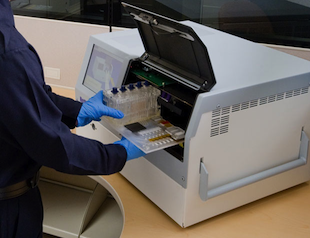On January 8, Emory University School of Medicine’s Department of Medicine Grand Rounds had an unusual format: a debate between Otis Brawley, MD and John Petros, MD on the topic of PSA testing.

Otis Brawley, MD
Prostate cancer is the second leading cause of cancer death for American men. PSA (prostate specific antigen) is a protein produced by the prostate gland and its levels can be measured by a simple blood test. A higher number could indicate prostate cancer, but the test doesn’t differentiate between an aggressive, fast-growing cancer, and one that is so slow-growing it wouldn’t threaten a man’s life.
Brawley, professor of hematology and medical oncology and chief medical officer for the American Cancer Society, led off the debate arguing that studies show PSA testing to be unreliable and possibly leading to too many diagnoses and unnecessary treatment for prostate cancer. Petros, a professor of urology who treats prostate cancer patients, looked at other studies (more details below), which show the PSA test to be a tool that has helped save lives by detecting prostate cancer at earlier stages.
In May 2012, the U.S. Preventive Services Task Force issued a “grade D” rating for PSA screening, saying the practice offers more harms — in terms of complications from PSA-test-driven treatment such as incontinence and blood clots — than benefits. Brawley agreed with this Ray Ban outlet assessment and says he’s not convinced the PSA test saves lives, but he doesn’t rule out its use. He framed this issue this way:
Pretend you are offered the choice of taking a pill that will double the risk of prostate cancer diagnosis from 10 to 20 percent, but could decrease risk of prostate cancer death by one fifth: from 3 to 2.4 percent. “Do you feel lucky?” Brawley quipped.

John Petros, MD
As a counterpoint, Petros cited National Cancer Institute epidemiology data indicating that the rate of metastatic prostate cancer has substantially decreased over the last few decades, since prostate cancers are now being diagnosed at an earlier stage. He also went over studies conducted in Sweden (Goteborg) and in Austria (Tyrol), which show significant reductions in prostate cancer-related mortality coming from PSA testing.
Five things Brawley and Petros agreed on:
- PSA testing should be performed in the context of a physician-patient relationship, with men making an informed decision about the value of the information they will receive and the associated risks.
- Vans in supermarket parking lots – more broadly, community- or employer-based screening — are not the ideal setting for PSA testing.
- The PLCO study, a NCI-sponsored randomized clinical trial to examine the effects of screening on cancer-related mortality, was flawed. In particular, the “control†arm had a substantial rate of PSA testing.
- Brawley said: “Some cancers that are detected early do not pose a threat and do not need to be treated.†Similarly, Petros said: “Prostate cancer can be low risk if safely observed, but high risk forms are lethal. We need to focus on cancers that matter.â€
- Biomarkers that are better than PSA alone are needed. Brawley said: “We need a 2013 definition of prostate cancer, informed by genomics, rather than going by what Virchow decided prostate cancer looks like under the microscope 160 years ago.â€
Petros agreed with this last point and noted that more sophisticated tests than PSA already have been identified such as the prostate health index, which measures levels for three forms of PSA and may be more cancer-specific. Research being conducted at Emory by Carlos Moreno and colleagues also moves toward this goal. In 2011, his team published results in the American Journal of Pathology on a panel of biomarkers that can predict prostate cancer outcomes after prostatectomy. The Atlanta Business Chronicle recently had a story on a patent related to Moreno’s research.
Petros said a key question, and one he and Moreno are planning on testing, is whether the same biomarkers could be useful on prostate biopsy samples. This could help make treatment decisions regarding surgery vs radiation. Biopsy-based tests could be combined with data based on urine biomarkers, to get around the problem of tumor heterogeneity and imperfect sampling, Petros said.
For now, Petros said he believes in initiating a conversation about PSA screening with patients 50 and older, or younger if they have risk factors for the disease.  He said the decision to have routine PSA testing, follow-up tests and prostate cancer treatments, is a very individualized process.
“It comes down to, what do you tell the man standing in front of you?†he said. “You have to consider where they are in life and what their goals are, and that varies with every man.â€











 Larry Young is quoted extensively in
Larry Young is quoted extensively in 
